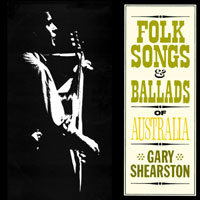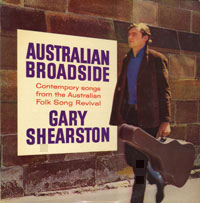THREE EARLY RECORDINGS OF GARY SHEARSTON:
A Personal Reflection

In 1960 I went to see the production of a television programme called “The Channel Nine-Pins”. This was a very popular afternoon children’s show in Sydney. Each week part of the programme featured a game show where contestants won prizes when they identified popular tunes. “Name That Tune” was hosted by Gary Shearston.
A few years later Shearston became well-known as an Australian folk singer. During this time he lived for a short while in North Sydney, in the same street that I did. Quite often I would see him walking down our street, usually carrying a guitar case. I later learnt that he was involved in some of the productions at the Ensemble Theatre, on Careening Cove, and that he also did some concerts there. The Ensemble was almost next door to Milson Park, where my friends and I often played. I remember seeing him walking in the park.
As Gary Shearston’s popularity grew, it was through radio and television that I started to become familiar with the type of music he was playing.
1964 was my final year at high school and I was already keenly interested in Australian history. I suppose it is not surprising that one of the first long-playing records I ever owned was Gary Shearston’s Folk Songs and Ballads of Australia, CBS (BP 233094). I bought the LP in May 1964, with money given to me for my sixteenth birthday.
A sparsely produced collection of songs about Australia and its history, this recording made a significant impression on me. Through the songs, stories were told featuring Australian places, familiar expressions and colloquialisms. The songs were drawn from a tradition of songs and here was someone unashamedly singing them in an Australian accent.
 I had not heard most of the songs before, so the record acted as a great introduction to Australian songs. I was particularly intrigued by the way these songs not only entertained you but also told you things as well. It seemed a great way of teaching people about Australia’s history, making it interesting and accessible at the same time. In later years I used many of these songs in my own teaching of Australian history to school children.
I had not heard most of the songs before, so the record acted as a great introduction to Australian songs. I was particularly intrigued by the way these songs not only entertained you but also told you things as well. It seemed a great way of teaching people about Australia’s history, making it interesting and accessible at the same time. In later years I used many of these songs in my own teaching of Australian history to school children.
Folk Songs And Ballads of Australia was, and still is, a wonderful collection of songs. Released in April 1964, it featured Gary Shearston singing and playing guitar and harmonica, accompanied by Les Miller on second guitar and banjo. As the cover notes reveal, the recording was “the realisation of an ambition of Gary’s to do for the songs of Australia what has been done elsewhere, notably America”. Shearston wrote: “Folk song – traditional and contemporary – serves as an integral part of the oral record of a country’s history.” There are songs about convicts, shearers, bushrangers, drovers and pioneers of Australia.
 The record introduced me to the work of Australian songwriter Don Henderson, his “Put A Light In Every Country Window” being the opening song. Chris Kempster’s beautiful musical adaptation of the Henry Lawson poem “Reedy River” is there too. The possibility of successfully setting Australian poetry to this musical genre is further evidenced by the songs “The Bush Girl” and “Bonnie Jess”, the latter a poem by Thomas E. Spencer, set to music by Shearston. I was fascinated by the way these poems were given a new musical lease of life, increasing their chances of reaching a wider audience.
The record introduced me to the work of Australian songwriter Don Henderson, his “Put A Light In Every Country Window” being the opening song. Chris Kempster’s beautiful musical adaptation of the Henry Lawson poem “Reedy River” is there too. The possibility of successfully setting Australian poetry to this musical genre is further evidenced by the songs “The Bush Girl” and “Bonnie Jess”, the latter a poem by Thomas E. Spencer, set to music by Shearston. I was fascinated by the way these poems were given a new musical lease of life, increasing their chances of reaching a wider audience.
When the American folk singing trio Peter Paul and Mary toured Australia in June 1964, a Sydney newspaper published a photograph of them holding a copy of Shearston’s record. They later included Shearston’s song “Sometime Lovin’” on one of their albums.
During this time Australians were hearing the songs of protest that were coming from overseas, especially America. Shearston’s second CBS LP recording Songs Of Our Time (BP 233133) was released in July 1964. It showcased some of these songs of war and peace, racial discrimination and social injustice. But interspersed with the songs of Dylan, Seeger and McColl, it was refreshing to find some Australian songs. The writings of Dorothy Hewitt, Don Henderson, Kath Walker (Oodgeroo Noonuccal) and Shearston were included.
In March 1965 Shearston followed this album with Australian Broadside, CBS (BP 233186). It was subtitled “Contemporary songs from the Australian Folk Song Revival”. Shearston was again joined by Les Miller on banjo, six and twelve-string guitar. Richard Brooks also contributed significantly with his harmonica.  His sensitive playing, along with some beautiful, subtle counter melodies, created the perfect musical setting for these songs. The sparseness of the arrangements gave a real intimacy to the performances and allowed Shearston’s vocals to be clearly heard. And this was a collection of songs that demanded their lyric be heard.
His sensitive playing, along with some beautiful, subtle counter melodies, created the perfect musical setting for these songs. The sparseness of the arrangements gave a real intimacy to the performances and allowed Shearston’s vocals to be clearly heard. And this was a collection of songs that demanded their lyric be heard.
Australian Broadside introduced me to writers such as Dorothy Hewitt, Denis Kevans, Mona Brand and Dougie Young. It also included original material from Shearston. “The Voyager”, for example, showed Shearson’s ability to respond quickly, concisely and effectively in song to this tragic maritime accident, at the same time reflecting seriously on its significance.
I cannot overemphasize the impact these songs and their singer had on me. The songs were creative responses to events that were then pertinent to Australia. They were not rehashed ideas from overseas. They drew on Australian experiences. They were further evidence of the power that a song could possess in peacefully presenting a certain viewpoint.
Gary Shearston went on to perform and record a wealth of wonderful songs, many of them his own compositions. And he continues to do so. He has contributed significantly to Australia’s rich musical tradition. I feel very fortunate to have heard his three early recordings back in the 1960’s.
© Jim Low 2004
